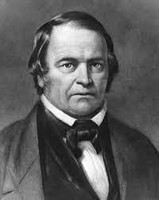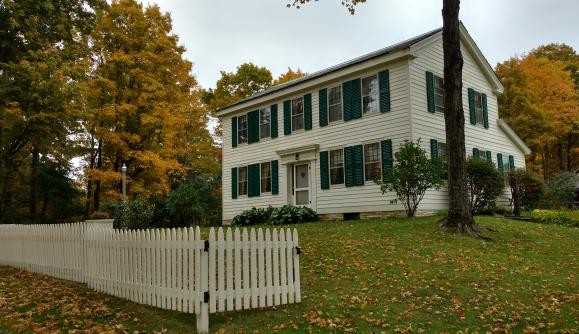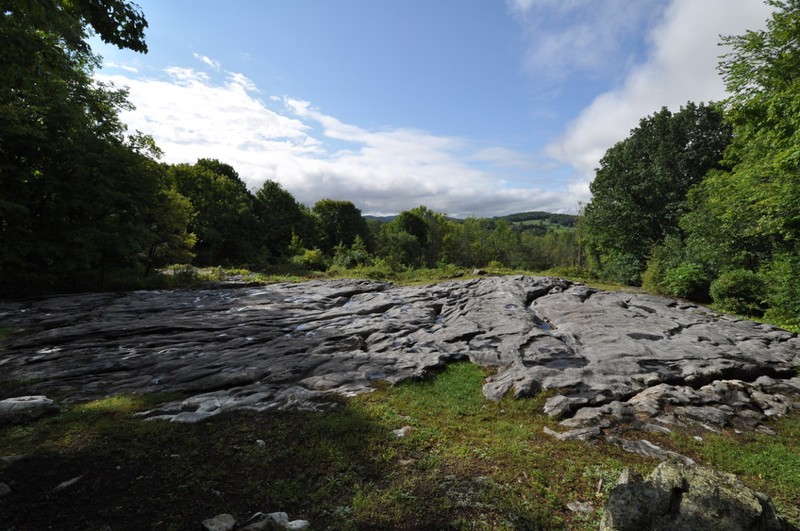William Miller Home and Ascension Rock (Millerite movement)
Introduction
Text-to-speech Audio
This home was the epicenter of one of the largest new Christian sects that developed in the 1830s and 1840s. This was a time when numerous religious reform movements, utopian communities, and experiments with different communal lifestyles developed in New York and New England. The Millerites were followers of the minister William Miller who lived here and began preaching that the world would end in 1844. Many of Miller's followers came to live with him at his home in Whitehall, where they awaited the end of the world first on April 18, 1844, and then again on October 22, 1844. When both of the dates Miller held out as the end of the world passed, some of his followers left while others used the period (known among Millerites as the Great Disappointment), to reassess their beliefs and focus on the fundamental idea that Jesus would return and his followers should prepare. These former Millerites turned away from Miller's emphasis on prophecy and a precise day of Jesus's arrival (known as the Advent) and instead focussed on preparing to meet Jesus either as a result of the Advent or the end of their natural lives. Some of Miller's supporters established the Seventh Day Adventist Church while others established the Advent Christian Church. Miller's home, chapel, and Ascension Rock are listed on the National Register of Historic Places.
Images
William Miller

The Miller home

The Miller chapel

Ascension Rock

Backstory and Context
Text-to-speech Audio
The mid-1800s witnessed a proliferation of new religious movements and charismatic ministers. One of period's most well-known ministers was William Miller, a devout Baptist. Miller was born in Massachusetts but spent much of his life in New York. Miller served in the War of 1812, and it was during the war that he had what was perhaps a life-altering experience. Early in his military career, Miller fell out of a wagon and suffered a head injury and there is some speculation that the injury altered Miller's personality. He abandoned his lifelong Baptist faith and instead embraced Deism. He also became progressively more consumed by his study of the Bible.
As early as 1818, Miller began to make calculations predicting the end of the world. Based on a literal interpretation of the first chapters of Genesis as well as other Biblical prophecies. Based on his calculations, Miller predicted that Jesus would return to Earth on October 22, 1844. His predictions and his publication of a book detailing his theory in 1831 made Miller a popular speaker in the northeast United States. He was particularly active in preaching in New York and Vermont (his home at Whitehall is just over the New York border from Vermont), but gained a following throughout New England.
Some people were understandably skeptical of Miller's prophecies, but he gradually gained followers. By the 1840s, Miller had a following of perhaps between 50,000 and 100,000, some of whom lived in eastern Massachusetts and some in New York. Many of the Millerites, as they came to be known, left homes and farms and sold all of their belongings to go and wait with Miller for the end of the world. There are accounts of Millerites who broke apart all of their furniture and other belongings, believing that they would soon be "taken up" and would no longer need earthly possessions. Women reportedly cut their hair and took the ruffles off of their dresses, while some Millerites made long, white gowns to await the day when they would all be swept up into the afterlife. A comet that swept over the skies of Massachusetts early in 1844 was interpreted by some people as a harbinger of Miller's prophecy.
October 22, 1844, came and went with no celestial event. Thousands of Millerites in New England and the Miller homestead in New York awaited the moment of Jesus' second coming, with the Whitehall Millerites choosing the massive outcropping of rock that they christened "Ascension Rock" for the occasion. The day then came to be known as the Great Disappointment by Miller's followers, some of whom were left disillusioned and confused in the wake of the Great Disappointment. More than a few were left impoverished after giving away or simply abandoning their homes and possessions. Miller continued to believe and in 1848, he built a small chapel on his property where he and the remaining Millerites would gather. However, some of the former Millerites moved in different directions, eventually creating out of the remnants of the Millerite movement the Advent Christian Church and the Seventh Day Adventist Church. William Miller and his wife, Lucy, are buried in a nearby cemetery. The home, chapel, and Ascension Rock are all listed on the National Register of Historic Places.
Sources
Voorheis, Alice . Remembering a Special 175th Anniversary, Southern Tidings . Accessed June 26th 2022. https://www.southerntidings.com/feature/remembering-a-special-175th-anniversary/.
The William Miller Chapel , Historical Marker Database . Accessed June 26th 2022. https://www.hmdb.org/m.asp?m=58227.
The Day the World Didn't End , Sun Community News . Accessed June 26th 2022. https://suncommunitynews.com/news/3352/the-day-the-world-didnt-end/.
William Miller Convinced Thousands of Millerites the End was Near , New England Historical Society . Accessed June 26th 2022. https://www.newenglandhistoricalsociety.com/william-miller-convinced-thousands-millerites-world-end/.
